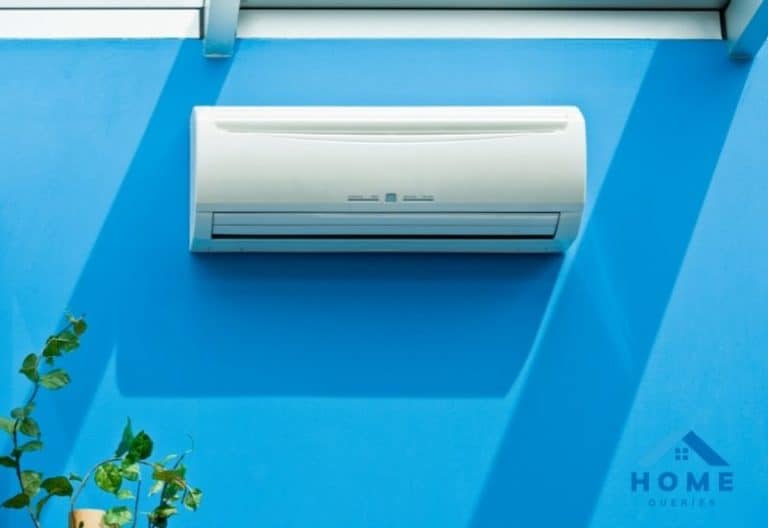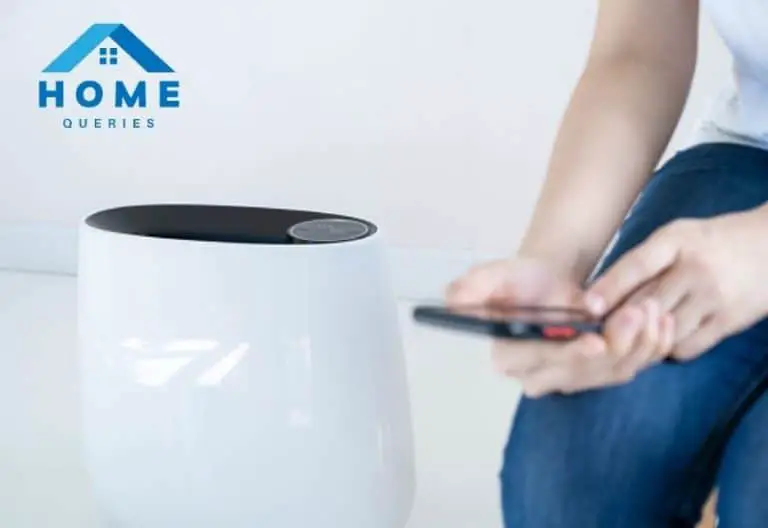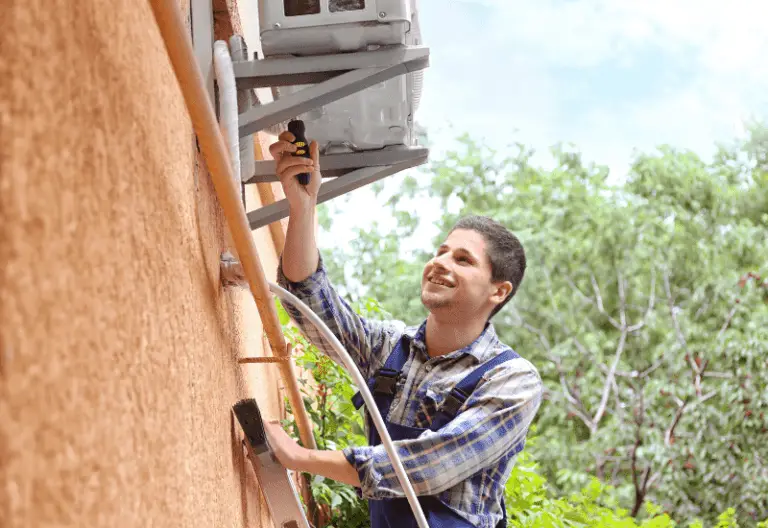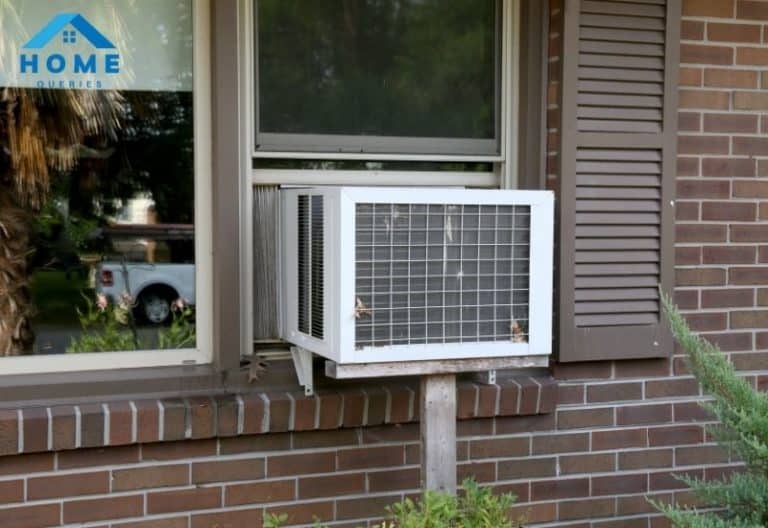10 Common Window Air Conditioner Thermostat Troubleshooting
Maybe you have a problem with your furnace air conditioning system or your heat pump. You’re just not sure what that problem is. You suspect the thermostat. I’m going to have over 10 troubles today.

1. The Thermostat Location
Now there are many reasons why your thermostat‘s location is bad. I am going to describe them. So if your thermostat is mounted on the exterior wall, you never want to have a thermostat mounted on the exterior wall.
Because there’s a temperature exchange with the outside temperature, that will give you an incorrect temperature. So if it’s during wintertime, you’re gonna read a lower temperature than it is in the building, and during the summer, you’re gonna read a higher temperature than what it is actually in the building.
You also don’t want to have it near a window or door because you’re just gonna be letting in that. That temperature exchange once again. If you open up the door, you’re gonna be allowing a lot of this hot air from during summer in, and it’s gonna throw the thermostat off. You also don’t have it near a lamp, especially if you have an incandescent bulb.
So if you are trying to turn your heat on in the middle of winter, it’s going to read the heat coming off of the incandescent bulb, and it’s not going to turn off. So maybe the reading temperature says 74 net in the house, but it’s 68 in the house, and that’s just due to the heat coming off of the bulb.
You also don’t want to have it located near a supply register. During the summer, it’s going to end up shutting the thermostat off prematurely, and during the wintertime, once again, it’s gonna do the same things because it’s going to be pushing that heat right across the thermostat and read a much higher temperature than it is in the middle of the building.
So the best location to have this is in the middle of the building on an interior wall near the return. Also, try to avoid corners if possible. Try to get into the middle of the building where you have airflow moving, and remember that you have supply registers near the exterior walls of the building, and you have your return grills near the interior walls.
So you have this air movement through the building, and your actual temperature in the building is going to be measured on your interior wall.
2. Loose Connection At The Thermostat
Nest thermostats don’t have screws to hold the wires in, and you may think the wire is in. So, for instance, you can push in, and the side can be down. But sometimes, you can just pull them, and that’s a problem.
So anytime that you push wires into a Nest thermostat, you should be sure that you can’t pull them out. When you pull on it, you’re scoring the wire up against what’s holding the wire in there, and that’s gonna allow for an even better connection.
You want to make sure that you’re pushing them in all the way and testing them once you think that you’re done.
Then take another thermostat that has flathead screwdriver terminals, and you want to make sure that these are tight as well. You always want to make sure that they use a screwdriver with a larger handle. So a little bit wider of a handle but such as you take the one.
Some handles are round. You never want to use those because you just can’t get enough torque on them, and you go ahead and put it in there you want to. You want to make sure that you torque down on that to make sure that the connection is good.
So just check your electrical connections at your thermostat and over at your furnace or your air handler control board. Look at your furnace control board, and you want to just go in and check these connections. Make sure that they’re completely sung and if you see that one was any kind of loose, then fix it.
Now the other thing that you want to be aware of is that you will be able to see a little exposed copper. So you have the insulation cut back before it goes underneath the flat part of the terminal. I know it’s kind of hard to see, but you want a lot of exposed copper out there because there are not two wires touching, but in this case, you will see it’s only partially stripped.
That one side stripped, and one side unstripped would be a problem where it’s just making barely intermittent contact rate on the terminal.
Read more: How Much Does A 5 Ton Air Conditioner Weighs?
3. No C Wire And Battery Power Are Low.
When a thermostat is powered by batteries only and not from the c-terminal from the air handler or the furnace, if you have an AC terminal in the thermostat, what you can do is you power the thermostat with 24 volts through the or terminal, it powers the load of the thermostat, and it goes back through the C terminal, back to the furnace, or air handling control board.
Some thermostats don’t have a C terminal, and some have an optional C terminal or battery. You can choose one or the other, or you can have both.
In some cases, thermostats are powered by batteries only, and if you see that the batteries are low, it says to replace the batteries. In this case, the thermostat will not operate at all, but in some cases, it will say low battery, and the thermostat will still function.
Sometimes it won’t say low battery at all, but there will be a problem with the batteries, and they will be low and what’s happening is you’re trying to turn your fan on or your heat on or your air conditioning on. There’s not enough power in the thermostat to close the electrical contacts to turn the system on.
So, that could be the problem. Now I’m gonna tell you about the battery compartment there could be a couple of other problems as well. Another problem you can have is when you replace the batteries, you could have a little bit of corrosion on the terminals. So, in this case, this one battery was leaking, and you replaced it with brand new batteries. But you’re still not getting your voltage to your display.
Another thing is, you just have your batteries, the batteries are bad, and they should be 1.5 volt apiece which equals 3 volts. When you get a brand new battery, there is usually gonna be about 1.6 apiece, and in this case, you may see that it has only 2.25 volts total. So you should go ahead and replace these batteries.
Your thermostat may have a wire wired right into the C terminal, and that wire goes back to the furnace control board on the C terminal. This type of thermostat does not need batteries to operate.
4. Mercury Thermostat Problems
Your thermostat may not level, and it may have another issue. But being level is very important to a mercury thermostat. Because you have mercury in these little balls, even if your thermostat was installed level from the beginning, it could have loosened up over time.
The wall anchors could be sliding around, and that could be an issue. You can have this little metallic that could be out of their parameters. You can have the heat anticipator down here could be incorrectly set. So if the thermostat was shutting the heat off prematurely, it might need to be increased slightly higher.
You can have several problems with a mercury thermostat, and you can get away from having these problems with a digital thermostat. Because even if a digital thermostat was installed and it’s not quite level, it’s still gonna be able to keep the accurate tempers at the building.
5. Thermostat Wired Incorrectly
To the indoor unit control board, you could have selected the improper thermostat for the particular system. In this case, it’s a furnace, and it has G CW Y and R. So if you selected a heat pump thermostat, it has an emergency heat, and it also will power the Y terminal even in heating mode. On a thermostat such as this, we would use for air conditioning, and it’s only going to power the W during the heat mode and not the Y during heat mode.
Some have selectors on the back as well, so you can go ahead and select if it’s for heat pump or gas. It could be the thermostat itself that you’re trying to use is incorrect, or you could have maybe the wiring incorrect.
In this case, you can have a heat pump thermostat backplate that is wired incorrectly, and a lot of times, heat pumps are wired incorrectly, and homeowners have to push the button over to the emergency heat entirely too often, and they may not have that auxiliary strip heating being powered automatically by the thermostat.
Anytime the heat pump cannot keep up with the demand for heat in the building. It turns on the auxiliary strip heating as well as keeps the heat pump running until you’re able to get the temperature up in the building. Then after that, it turns off the electric strip heating and then just runs the heat pump. The reason is, this is in the wrong spot. Because it’s only powering over to auxiliary, and there’s no coming out of it.
The little jumper needs to go between Aux and E. It only takes one wire being in the wrong spot to have high electric bills or an uncomfortable temperature in the house. And the system just doesn’t seem to be performing correctly, but it’s just the control wiring.
6. Wires Intermittently Touch Each Other Or The Ground.
Maybe your wire was brought through, and it’s rubbing the insulation right off the wires, and in this case, see if this wore through the rubber inside that was provided by the furnace manufacturer. In this situation, wires are gonna be safe, but you may see that it’s just barely going to rub the green casing off of that wire, and it’s gonna be touching that ground frame. So you can have a problem with that.
You have two wires that are stripped back too far, and they’re just barely touching. You can sometimes have when you’re turning your furnace on, and you’re also gonna turn your air conditioner on. Because the W wire is for heat and the Y wire is for cooling. So anytime you’re sending 24 volts from the red from the R to the W, you could accidentally be sending it to the Y. So you should make sure to not strip the wires back that far and over.
You have another possible problem, and you have all these squished into the same area and always try to separate those wires out. Because you don’t want them to be compressed up against each other even though there’s insulation, if they’re pressed up against each other too tight, they could accidentally touch each other. So, in this case, Angie could be touching, and the fan could be turning on and even if the thermostat is not cooling for the same.
Another problem that can happen is if you’re going to stale a thermostat wire in place, you should make sure that it’s not tight. You may see this one’s hit down too hard.
Another problem that can happen is if you miss the staple and hit the thermostat wire; what’s going to happen is the wire inside this casing will end up shorting since they’re smushed together so tight. So a way to get away from hitting the thermostat wire accidentally or squishing the thermostat wire is just hitting the staple in beforehand, and then he just zips ties the wire to it.
So that’s a good method. You have to make sure that whatever method you use that the thermostat wire still has played, and you can still move it a little bit.
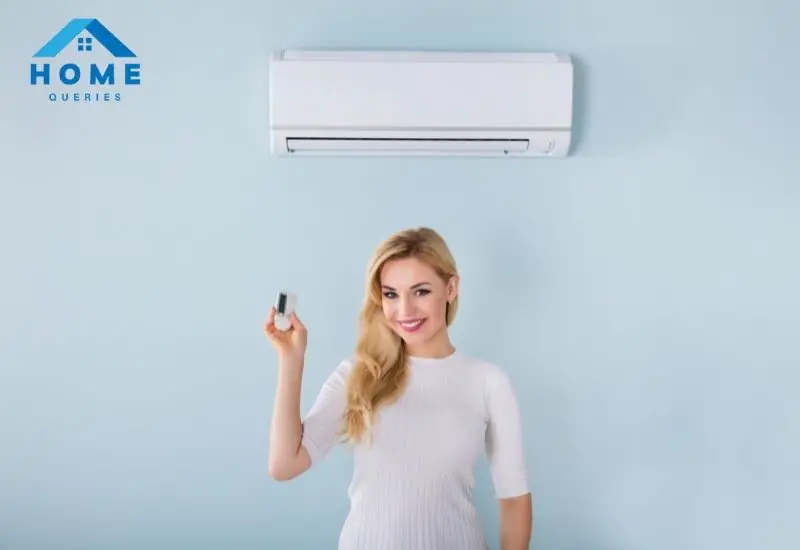
7. Wire Nicked Or Broke Apart.
If a thermostat wire stripped improperly and it was nicked, maybe it’s not making the full connection. So when you strip a wire, you shouldn’t go ahead and take it and go around because what’s gonna happen is that wires gonna be scratched on the outside.
You just pull away. You don’t want to keep circling. That’s not good. Another tool that you shouldn’t use is diagonal pliers because what’s happening is that you’re squishing down on the thermostat wire. The other thing is if you don’t turn it, there’s no way to cut each side of the outer wire casing.
You should stay away from this tool whenever possible, and you would just use wire strippers that are made for different sizes. So, for instance, you can check one which is made for 18, 16, 14, gauge, 12 gauge, 10 gauge, and also the 20 gauge up. So this tool is a good tool to use.
You should make sure that the wires stay intact while you’re stripping them. When you’re splicing thermostat wires, and you’re using nuts. The same thing applies. You don’t want to be taking these diagonal pliers in a circle. Because what’s happening is you’re nicking the outside of the wire.
When you’re putting your wire not on, you’re spinning these wires a little bit. So as you’re trying to tighten them, you’re spinning them, and one of them could end up coming off. You just move the wire, and it falls right out of the wire nut. It ends up getting cut right here when you go to cut it into a wire nut. So you can see, your wire is nicked pretty well from both sides.
A lot of times, that’s why you will end up falling out time, or it’ll just break off if you touch the wire nut and you touch the wire. This wire ends up breaking. But it may work in the beginning, and later on, it stops working just because of a resistance buildup. But where the wire ends up breaking just due to vibrations or something like that.
So you have to avoid this whenever possible. Just put your wire strippers on and pull. Never spin.
Another problem you can have is that a mouse has chewed your thermostat wire, and this happens quite a bit, at least where you’re located, especially when the thermostat wire runs through a crawl space. So something to be aware of: they could have broken one or more of the thermostat wires.
You can also have a bad connection at a wire nut or space connector, especially if they get corroded or have any weather get to them. So you should make sure that these are not exposed outside because you have voltage going through them, and they’re your connection points for the wire. So, this one may have a bad connection point, and the connection broke inside the wire.
8. Thermostat Program Settings Are Incorrect.
If a thermostat wire stripped improperly and it was nicked, maybe it’s not making the full connection. So when you strip a wire, you shouldn’t go ahead and take it and go around because what’s gonna happen is that wires gonna be scratched on the outside.
You just pull away. You don’t want to keep circling. That’s not good. Another tool that you shouldn’t use is diagonal pliers because what’s happening is that you’re squishing down on the thermostat wire. The other thing is if you don’t turn it, there’s no way to cut each side of the outer wire casing.
You should stay away from this tool whenever possible, and you would just use wire strippers that are made for different sizes. So, for instance, you can check one which is made for 18, 16, 14, gauge, 12 gauge, 10 gauge, and also the 20 gauge up. So this tool is a good tool to use.
You should make sure that the wires stay intact while you’re stripping them. When you’re splicing thermostat wires, and you’re using nuts. The same thing applies. You don’t want to be taking these diagonal pliers in a circle. Because what’s happening is you’re nicking the outside of the wire.
When you’re putting your wire not on, you’re spinning these wires a little bit. So as you’re trying to tighten them, you’re spinning them, and one of them could end up coming off. You just move the wire, and it falls right out of the wire nut. It ends up getting cut right here when you go to cut it into a wire nut. So you can see, your wire is nicked pretty well from both sides.
A lot of times, that’s why you will end up falling out time, or it’ll just break off if you touch the wire nut and you touch the wire. This wire ends up breaking. But it may work in the beginning, and later on, it stops working just because of a resistance buildup. But where the wire ends up breaking just due to vibrations or something like that.
So you have to avoid this whenever possible. Just put your wire strippers on and pull. Never spin.
Another problem you can have is that a mouse has chewed your thermostat wire, and this happens quite a bit, at least where you’re located, especially when the thermostat wire runs through a crawl space. So something to be aware of: they could have broken one or more of the thermostat wires.
You can also have a bad connection at a wire nut or space connector, especially if they get corroded or have any weather get to them. So you should make sure that these are not exposed outside because you have voltage going through them, and they’re your connection points for the wire. So, this one may have a bad connection point, and the connection broke inside the wire.
9. Hole In The Wall, Attic Crawlspace Throwing Off Temp
The thermostat is getting cold air coming in from the back. For instance, if you don’t feel this in, maybe with some silicon, you can fill that hole right in. The other thing is you could have a hole up in the attic or the crawlspace, and that’s not good. Because you could have your thermostat wire is running through there, but then you have cold air up in the attic, and cold air falls right down, and it comes right through the hole, right to the temperature sensor on the thermostat.
Now you will look up at the attic, and you will see a double top plate on the wall and the ceiling. There’s no insulation right in this area, but even if there was a little bit of insulation, you’re still gonna have cold air in the middle of the attic traveling down through this whole down to the thermostat on the wall.
So you have to make sure that this hole is filled in with rock wool or fire foam to seal this off.
10. Thermostat, Control Board, Or Other Components Bad
If the thermostat is bad or one of the components that the thermostat is controlling is the first step in some type of a sequence such as a sequence of operation for heat, one of those parts could be bad.
You got to know how to troubleshoot the thermostat, and the thermostat is connected to your control board, and you got to remember that or comes off of the control board as 24 volts to the thermostat and inside the thermostat or either touches to W or Y or G. So if you turn your heat on or touch W to turn your inducer motor on. But maybe your control board is not sending voltage to the inducer motor, or maybe the capacitor for the inducer motor is bad.
So the capacitor looks odd. Or maybe the inducer motor is bad. Another thing could be if your thermostats are trying to turn the fan on, then touch R and G., And you can measure that with a multimeter at your control board between common and G with your two multimeter probes.
You’re trying to measure 24 volts. What happens is the control board is then sending voltage over to your blower motor for that to turn on, but maybe the capacitors are bad, or maybe the blower motor itself is bad.
Maybe the control board itself is not able to send out the voltage. Maybe the relay is bad underneath one of those boxes.
Conclusion
I have explained 10 common window air conditioner thermostat troubleshooting. I hope this will help you to make a wise decision. Make a decision, live with it happily. Good luck!


